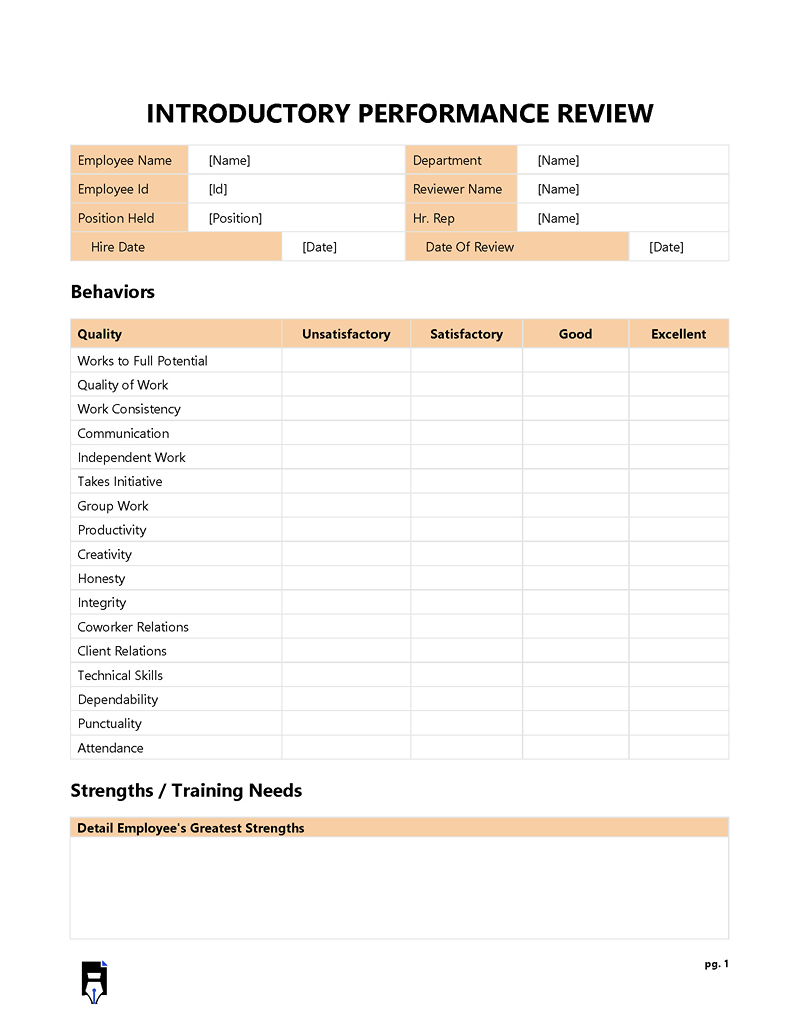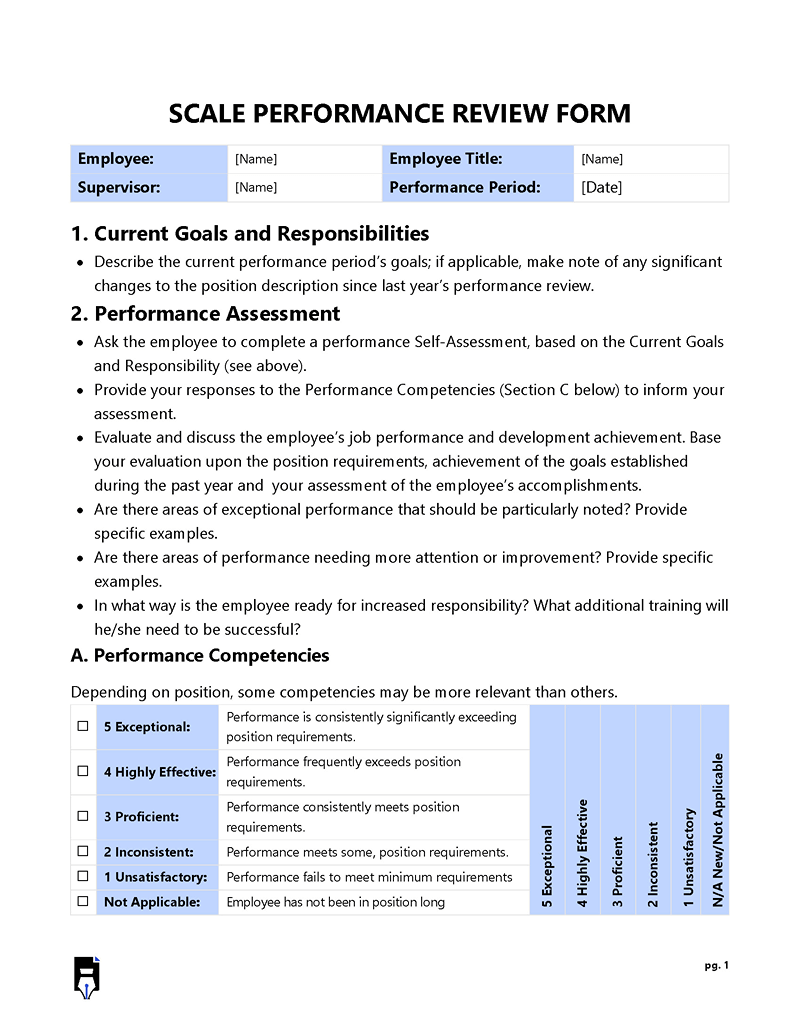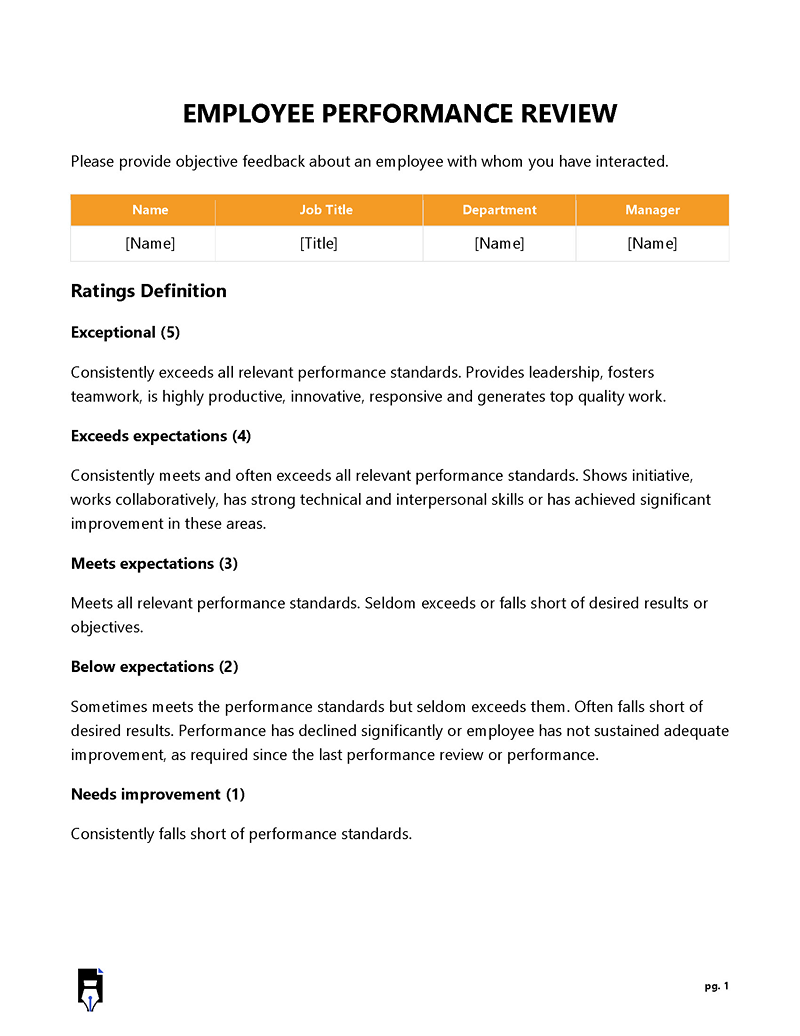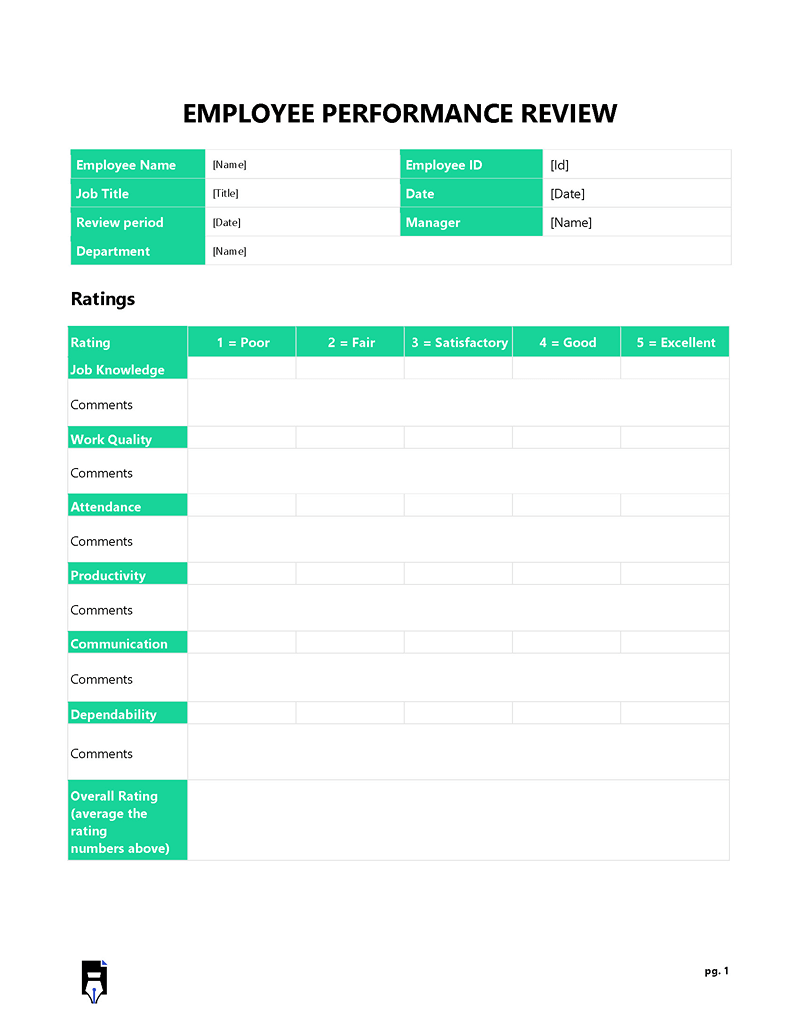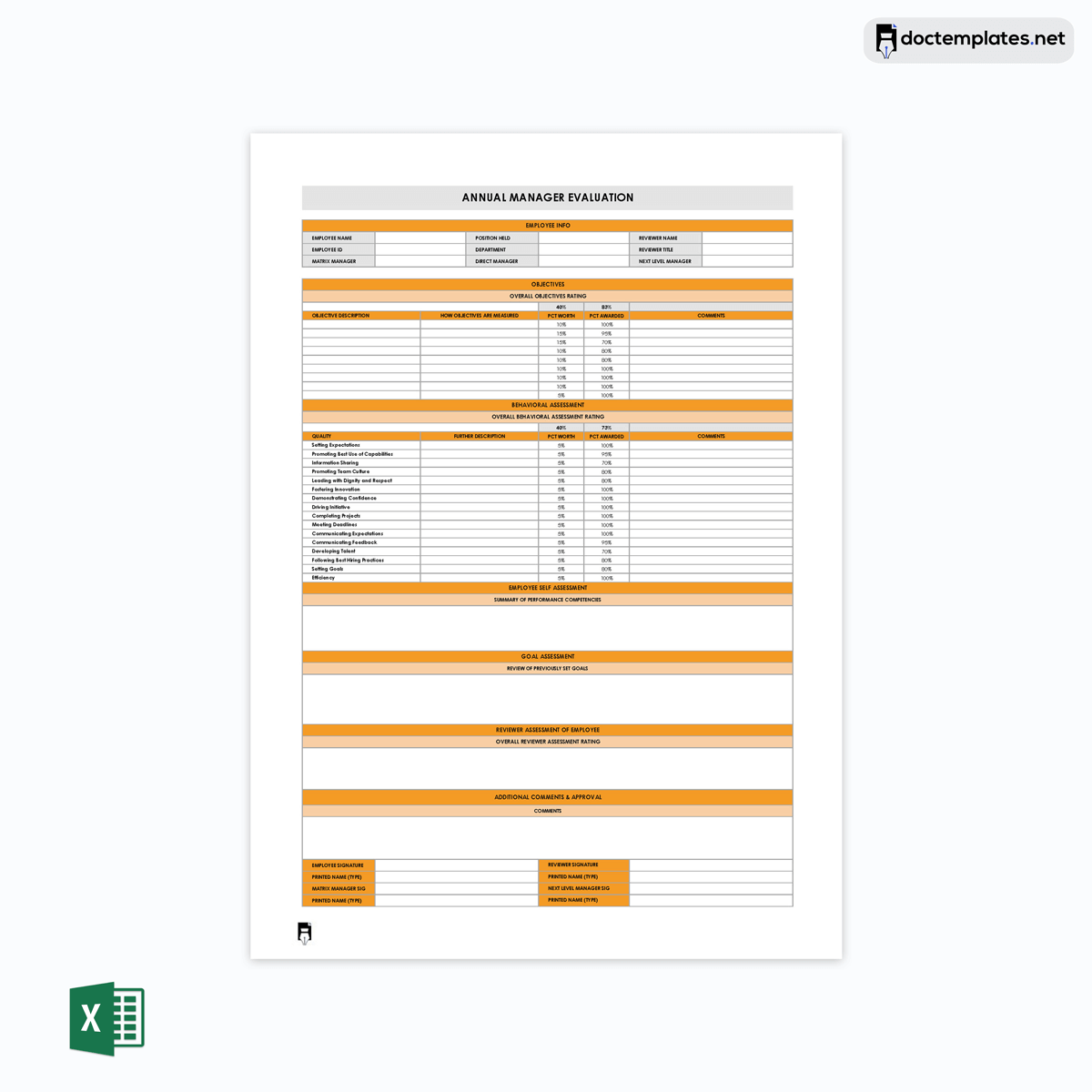An employee performance evaluation form is defined as a document that provides objective feedback/review on an employee’s performance at work.
It indicates the employee’s strengths and weaknesses in their role at the company. Each employee is assessed independently to determine what they did well and identify areas of improvement. Performance evaluations are normally performed, typically annually or bi-annually.
You can use this information to determine an employee’s training deficiencies and suitability for advancement and calculate compensation. The evaluation can be conducted using virtual performance evaluation software. However, a specialized HR management tool is not mandatory for the process, and a company can proceed as applicable to its situation.
There are two formats of performance evaluation forms, scorecard and narrative. A scorecard quantitatively assesses an employee’s performance. It lists the employee’s job duties and personal qualities, which are rated, and then the employee is awarded a score at the end of the evaluation. A scorecard should be complemented with comments to eliminate ambiguity and validate the awarded score.
A narrative format is used to assess the employee’s performance qualitatively. The form has open-ended questions to guide the appraisal. For example, “What are the three key areas an employee should improve?” or “What are your three noteworthy achievements in the year that ended?” As the employee answers the questions, a two-way conversation can be cultivated, which helps gather more detailed and accurate information.
Most companies will use a combination that merges the strengths from both scorecard and narrative formats. This way, qualitative and quantitative information can be collected to conduct a more thorough evaluation. This approach also helps companies identify the factors that influence poor and excellent results in the workplace.
Alternative names for these evaluation forms are:
- Performance review
- Performance appraisal
Stats: Large companies have ceased conducting traditional rating-based employee evaluations. However, 69% of companies are reported to still value and conduct them. Additionally, only 28% of employees believe that companies conduct performance evaluations properly.
Free Templates
Given below are performance evaluation templates:
This article is meant to educate you on what is a performance evaluation form, its importance, and how to conduct it appropriately. It will also discuss the information to include in an employee performance evaluation form.
Why Should You Use a Performance Evaluation Form?
Performance evaluations are part of the human resource management department. You can find ways to improve employee productivity by identifying employee strengths and weaknesses.
Following are the reasons why performance evaluation forms are essential:
- The forms contain a list of questions or statements meant to collect feedback on employee performance.
- By assessing employee performance, you can have a comprehensive evaluation report that helps you understand their strengths and weaknesses.
- Performance reviews help you identify proficient employees with outstanding qualities.
- Evaluation forms evaluate aspects such as goals, KPIs, efficiency, etc., used to make decisions regarding pay raises, layoffs, and promotions.
- Employees’ performance is also used as a basis for recognizing and rewarding employees.
- Performance assessments are used to plan employee training and development programs.
- You should use the forms as employees’ tools to perform their job duties.
- When conducting performance assessments, you can use the opportunity to remind employees of what is expected of them.
- By understanding employees’ individual capabilities, you can set performance goals and standards in the workplace.
- The evaluation form must be personalized and specific to the employee’s role.
- Ideally, the form should have a structured or narrative format.
- The form can follow a written, narrative approach to enable a seamless procedural evaluation process.
Statistical insights: 33.4% of employees claim they would like their managers to provide more feedback. It is also noted that employees who have engaged with their managers in the last six months are 2.8 times more likely to be engaged in their work. Additionally, 94% of employees claim they are likely to stay at companies that are invested in their careers. Lastly, it has been reported that a company’s commitment to accelerate career development is a “very important” consideration for most employees – millennials (31%), Gen Xers (31%), and baby boomers (18%).
What to Include in an Employee Performance Evaluation Form
Evaluation forms ought to be tailored to the specific employee and designation. However, key categories of information ought to appear in the forms.
Below is a detailed itemized list of all the details you should include in the form when evaluating an employee’s performance:
Employee and reviewer information
The form must collect the employee’s and reviewer’s identification details. This may include the names, departments, IDs, and designation of the employee and reviewer. This information is meant to identify the parties involved in the review.
Review period
You should record the review period for which the evaluation is being undertaken. For example, this can be the first or second half of the year for a bi-annual review or a year for an annual review. You should also note the date when the evaluation was conducted. The date is important in tracking the employee’s progress in between evaluations.
Employee strengths and shortcomings
The form should record the employee’s strengths and weaknesses based on their performance during the review period. The strengths are based on what the employee has already done, while the shortcomings highlight the areas of improvement. After identifying the strengths and shortcomings, you should provide feedback on how employees can optimize their current capabilities.
Rating scale
Each performance evaluation form requires a rating scale. You can use a numerical or non-numerical scale. A non-numerical scale is ideally preferred. This is because it does not focus on grading employees but on evaluating their competencies.
A good rating scale has several characteristics. It must be easily understood by the employees. Also, it must provide a shared language that can highlight successes, strengths, and areas of opportunity. Lastly, it must be able to demonstrate career growth.
Examples of rating scales include:
- Numerical: 1. Poor 2. Unsatisfactory 3. Satisfactory 4. Very satisfactory 5. Outstanding
- Non-numerical: Needs improvement, often meets expectations, consistently meets expectations, and exceeds expectations.
You should ensure that everyone on the team understands what each rating means. This is because different people can interpret the same rating differently, leading to inaccurate evaluations. However, when everyone is on the same page, an accurate evaluation can be undertaken.
Evaluation points
The form must contain all the evaluation areas. This can be specific skills or functions of the associated role. The evaluation points can be listed in a table that simplifies the rating.
Goals
Employers typically set goals for their employees. How well each employee has achieved these goals is an excellent measure of their performance. The form should thus indicate progress on existing goals and any future goals. This is an effective way to communicate your expectations and company standards to employees.
Comments/feedback
There should be a section to record comments that can be used to give feedback. This section can be used to make suggestions/recommendations, encourage employees, and report noteworthy accomplishments and challenges.
In addition, this section is useful in facilitating training and development materials and programs. Quality feedback should have the following properties – constructive, specific without ambiguity, personalized for the individual, consistent, and capable of achieving goals in between evaluations.
Signatures
Performance evaluation forms must be signed to guarantee that each party understands the form’s contents and the evaluation process. So, you and the employee ought to supply your signatures to authenticate the form.
7 Best Practices to Consider
For the performance evaluation process to be effective, it must be undertaken correctly. You have to ensure that it will boost productivity and benefit the company, the employee, and their career.
Statistical Insight: 65% of employees think that performance evaluations are insignificant to their jobs, as reported by HBR’s “People Don’t Want to be Compared” article.
Here are examples of best practices you can adopt when using performance evaluation forms:
Gather right information
Performance review should be an evidence-based exercise. You, therefore, need to ensure you are collecting the right information from your employees. So, determine the objective of the appraisal from the onset and incorporate the right questions and statements to guide the assessment.
Stay focused
You should not try to exhaust every evaluation point in one sitting or form. Instead, conduct several sessions to focus on different points independently so that you can make informed deductions and offer constructive feedback.
Provide clear description
Before you perform the assessment, the job duties, goals, and rating system must be clear to both parties (reviewer and employee). This fosters a seamless evaluation where both parties can adequately contribute.
Set an evaluation cycle
You should establish an evaluation cycle within the company. This ensures that you prepare adequately before each evaluation. The three common cycles are quarterly, bi-annually, or annually. In other cases, it can be monthly if the company culture and type of work allow.
Additionally, some cycles are suited for short-term goals and others for long-term goals. For example, quarterly evaluations would be suitable for short-term goals, while annual evaluations can be adequate for implementing feedback, setting, and working on long-term goals.
Pro tip: The time period between cycles should be used to observe job performance and actualize professional development programs.
Be objective
An employee performance evaluation form can be used to make critical decisions in a company. Therefore, it should be objective and free of any bias or personal opinions. You should thus avoid any subjective or ambiguous language to describe an employee’s competencies and offer feedback.
Use a template
You should consider using a template to prepare your performance evaluation form. They facilitate consistency and objectivity in evaluations. Also, templates are easy to modify and record progress from one review period to the next.
Provide and take feedback
Performance evaluations are meant to be two-way interactive exercises. Therefore, you should offer and receive feedback. Feedback from employees can help develop training programs. The evaluations are also an opportunity to learn about the employees’ needs and expectations. Understanding the employees’ needs helps improve management. To collect honest information, you should use avenues that employees are comfortable with, such as anonymous surveys, physical or virtual comment boxes, or holding team feedback meetings.
Legal Considerations
Performance evaluation forms can have legal repercussions if poorly conducted. Therefore, you must ensure that the forms you use are properly written to avoid such legal liabilities.
There are several legal considerations you should pay attention to:
- First, do not use two different evaluation forms for two groups, as this may expose you to discrimination claims.
- Secondly, remember that the forms can be used in court as admissible evidence. This is often seen if a former employee claims that a wrongful act was done to them.
- Lastly, you should be careful when reporting poor performance for employees who have issues that may negatively impact their performance, such as safety violations, harassment, wage issues, etc. This is because employees are typically protected from discrimination and are entitled to different labor privileges and may thus choose to retaliate legally, which may cost the company.
Frequently Asked Questions
Do employee performance evaluation forms make sense for small businesses?
Small businesses should consider using performance evaluation forms as they can help produce a workforce that is beneficial to the company in the long term. Using predefined forms can help in conducting consistent assessments.
When should an employee evaluation form be used?
The form should document the results from each performance review, whether after each evaluation cycle or in between the cycle. You can use several forms, such as a general form, self-assessment form, and peer review, to get an accurate and detailed report on an employee’s performance.
Does an employee performance evaluation form need to be industry-specific?
Yes. The form should reflect the skills and qualities needed in your company’s specific industry. This is because the needs of a company vary from one industry to the next.
